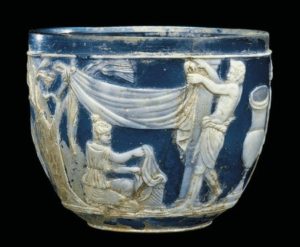That headline could apply to dozens of people, especially nowadays in this age of competitive, ostentatious collecting of contemporary and modern art. But I was referring to J. P. Morgan, who in his lifetime purchased more than 20,000 works of art, including rare books and manuscripts. And he did it all in the space of about 23 years, those after his father died. That’s more than two items a day, every day for 23 years.
 The sheer number astonishes, as do the results. Morgan bought:
The sheer number astonishes, as do the results. Morgan bought:
1,157 ancient Near East cylinder seals; 3,000 cuneiform tablets; 600 rare Medieval manuscripts; more than 800 portrait miniatures; 250 watches and clocks; the largest collection of Rembrandt etchings in the U.S.; nearly 250 Renaissance and Baroque bronze sculptures; the “most complete†collection of painted Renaissance enamels extant during his lifetime; more than 1,500 pieces of Chinese, Meissen, Sèvres and other porcelain; and about 130 snuff boxes. He bought paintings, glass, tapestries, on and on.
I take that paragraph from the review I wrote of Morgan: Mind of the Collector, now on view at the Wadsworth Atheneum in Hartford. It was published while I was away, with the headline A Mogul’s Voracious Appetite for Art.
In the exhibition, curator Linda Roth tries valiantly to explain Morgan’s collecting “mind,” but it’s difficult to do within a display of just 110 objects (including just a couple paintings). But I give her credit for trying! She focused on three areas:Â antiquities, sacred treasures and historical objects. Others might have found different themes.
I am posting here a picture of an an object, the Morgan Cup, that perhaps epitomizes her themes and his mindset. As I wrote in the review:
One scene-stealing object is a rare Roman cup (c. A.D. 1-99), just 2.5 inches tall. It’s a white-on-blue cameo glass depicting a woman making an offering to Silenus in hopes of becoming pregnant, and Morgan bought it at auction in Paris (outbidding the Petit Palais and Baron Edmond de Rothschild ) against the advice of curators from the Metropolitan Museum, who questioned its authenticity. But Morgan was right, and “the Morgan Cup†is now in the collection of the Corning Museum of Glass.
So, I say, go see the exhibit and think about the themes you might have chosen, even within this small sampling of his treasures.
